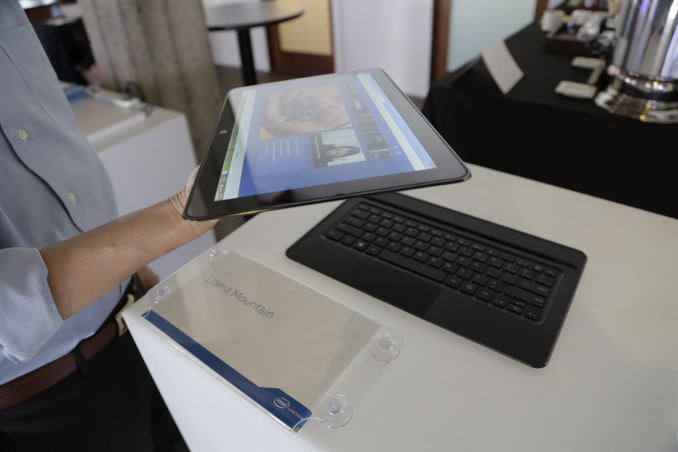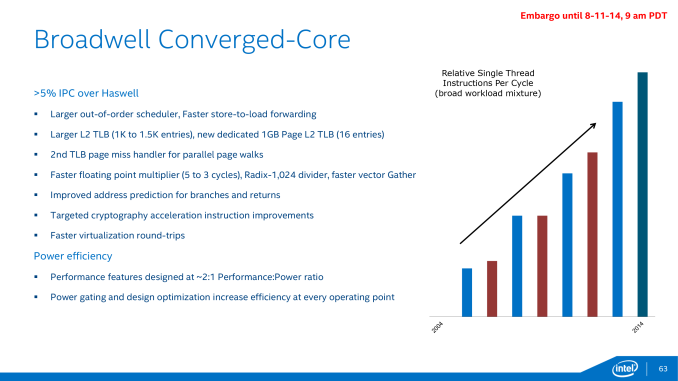Intel Broadwell Architecture Preview: A Glimpse into Core M
by Ryan Smith on August 11, 2014 12:01 PM ESTClosing Thoughts
Wrapping up our preview of the Broadwell architecture and Intel’s Core M processor, the bulk of Intel’s presentation and focus today is on the latter, so that is where we’ll start.
Core M is not a make-or-break product for Intel, but none the less it is a very important one. Mobile devices – be it tablets, slates, transformers, 2-in-1s etc – are continuing to increase in popularity, and as we’ve seen with ARM based tablets so far they form a market that has continued to grow and continued to erode the x86 laptop market that Intel has dominated for so long. Though laptops as a category are not going anywhere any time soon, their erosion means that Intel needs to get into mobile devices if they want to maintain their sales and their stature. To that end it’s not too late for Intel to break into this market and turn things around, but if they’re going to succeed then they need to make their move sooner or later, and this is where Core M fits in.
It’s telling then that while Intel is going after this market with a Core architecture, they are doing so under a different Core brand. Core M doesn’t just represent a new low powered Core CPU, but in Intel’s eyes is another product entirely. One that is so different that it does away with the Core i3/i5/i7 convention entirely and gets its own brand name and own product numbers. Core M is still Core, but it is nearly unrecognizable compared to the Core of even 4 years ago.
As far as the Core M product is concerned then, while Intel’s plans are grand they are not without merit. Backed by Intel’s new 14nm process and the Broadwell architecture, Core M looks like it should finally resolve the issues that dogged even Haswell-Y by bringing down power consumption even further while improving on Intel’s already strong performance, and getting the resulting processor in an SoC small enough to be usable in even the thinnest mobile devices. In fact from a technical perspective there’s little reason to doubt Core M; we’ll still have to wait to see just how good the resulting retail products are, but there shouldn’t be any technical reason for why it can’t be put into a mobile device comparable to today’s 10”+ tablets. Intel’s own Llama Mountain reference design can vouch for that much, showcasing the viability of Core M in a 12.5” tablet that’s just 7.2mm thick.
Intel's Llama Mountain, a Core M form factor reference design
More likely what will determine Core M’s fate and Intel’s ability to completely break into the mobile device market will be pricing. Intel’s profit margins are somewhat legendary in the computer industry, and a big part of that profitability has come from the high prices Intel has enjoyed from products such as their Core processors. Core M, like the other Cores before it, will still be an upscale product – a higher priced, higher performance alternative to Intel’s mass-market Atom processors. And while that makes plenty of sense on paper, in the real world Intel has to face the AllWinners and other ARM vendors of the world who are happy to sell their ARM SoCs at significantly lower margins, which can have a knock-on effect even if they can’t compete with Intel on overall performance. At this point it’s far too early to call this, especially when Intel isn’t even discussing Core M pricing at this time, but it’s a subject that Intel will have to consider carefully as “good enough” ARM devices will continue to be the biggest threat to Intel’s position in the CPU market.
Moving on, while today’s release from Intel only offers us a preview of what Intel will be delivering with their Broadwell architecture, what Intel has presented thus far looks to continue Intel’s tradition of relentless execution. As a tick Broadwell is a small but respectable improvement in Intel’s Core architecture, with the expected 5% IPC improvement in-line with previous ticks. For more traditional desktops and laptops it won’t radically change the world, but then it never was meant to. The biggest question for these parts will be whether Broadwell will improve on Haswell’s clockspeeds at all – a clockspeed boost made possible by Intel’s 14nm process – or if we’re going to hold steady similar to what we saw with the last tick, Ivy Bridge.
Meanwhile Broadwell’s GPU improvements are more significant, and in the race to further improve what’s essentially the baseline for PC GPU performance it is always welcome. Furthermore the fact that Intel is now at API feature parity with discrete GPUs is a big deal for Intel and it is a big deal for iGPUs as a whole. What we still want to see is more performance; a single slice seems just about right for Core M, but if we’re talking about larger laptop and desktop parts it would be very nice to see something akin to GT3 become baseline, especially with the die size savings Intel will be seeing from the 14nm process.
Finally, from here the rest of Intel’s 2014 should be rather busy. Next month is Intel’s Fall IDF 2014, at which point we expect we’ll be given a deeper look at Broadwell’s architecture. Past that the first Broadwell-Y based Core M processors will be on the shelves for the holidays, and with it our chance to see Broadwell and Intel’s 14nm process in action. However that will also be our only chance to see Broadwell in action this year; while Core M will ship in time for the holidays, the rest of the Broadwell lineup will not appear until 2015.













158 Comments
View All Comments
IntelUser2000 - Wednesday, August 13, 2014 - link
Broadwell Y's CPU portion is on 14nm but the PCH is on 32nm.Not to mention that Intel's 22nm process isn't that small compared to Foundries 28nm. 28nm Foundry is ~30% larger than Intel 22nm not 100%.
20nm Foundry is really a half node jump from 28nm considering density improves but performance much less. 16nm is another half node since density barely changes but perf improves.
Really, it can only be judged as a product.
mkozakewich - Thursday, August 14, 2014 - link
The 'myth' was that x86 was a horrible power-sucking pig. It was shown that it was possible to at least get close to ARM processors.Meanwhile, Intel's chips are NOT as low-performance as Apple's. The chip in Surface Pro 3 is about 2x-3x faster, and these should be about the same. With this year's Apple chip, imagine it to be 2x faster or so. Meanwhile, they'll probably both take the same amount of power. SoCs these days are running multiples of Watts. Even Intel Atoms used to take over 10, but now a full Intel Core computer can run under 6 Watts. It would be really interesting to run all these numbers and give a complete report on the state of mobile vs. notebook processing. They seem matched on power usage, but ARM chips are far cheaper and run at far less performance.
peevee - Monday, August 11, 2014 - link
Finally, a long awaited fanless design. I don't care about thickness that much as about energy waste on the heat and the fan to dissipate the heat.But... I have 2008 MacBook Pro with 2.4GHz Pentium M. If they achieved fanless design by bringing frequency down to, say, 1.8GHz, I am not interested (given that IPCs are not that different for real world applications). For me to upgrade, I want it to reach 3GHz, even if for a second and in a single thread, when starting applications for example. Anything below that is not a noticeable upgrade, and below 2.2GHz or so will be downgrade in practice.
And biggest problem of Intel is not how thick they processors are, it is Microsoft - with Windows 8 (and 8.1) being so unbelievably awful (yes, I do own it for a while). Krzanich should call Nadella immediately and tell him to fire Larson-Green, or they both are going down.
MikhailT - Monday, August 11, 2014 - link
You do realize this is for tablets and low power laptops (Chromebook/netbook style) only, right?It's not coming to MBP for any time soon unless you're talking about something else entirely, like the MBA, which also is not going to get M either because it'll be too big of a regression on the performance.
I don't think we'll see any Macs with Core M.
ZeDestructor - Monday, August 11, 2014 - link
You forget about IPC. Last I checked, compared to a Core 2 CPU at equal clock speeds, a Sandy Bridge CPU is 50+% faster on average, and Haswell is a further 15+% faster on top of that, all the while using less power.Krysto - Tuesday, August 12, 2014 - link
Since this is the FIRST core to be "fanless", they're probably squeezing a lot of stuff to make that work, and it probably still overheats. I wouldn't be too excited about it until we see how it does in actual devices, both from a power consumption point of view, but also a performance one (because if performance didn't matter, then we'd all just use ARM chips, no?).It would be laughable if Denver, which already beats mainstream Haswell Celeron, would be in range of Broadwell Y in performance, but still more energy efficient and with much better GPU performance.
UNCjigga - Monday, August 11, 2014 - link
Time to spin up the 12" iPad Pro rumor mill again...but would Apple really need to build a device that runs 64bit iOS *and* OS X?ilt24 - Monday, August 11, 2014 - link
Apple doesn't seem all that interested in adding touch screen capabilities to OSX.isa - Monday, August 11, 2014 - link
OK, I'm confused, so any help appreciated. I want to replace my old desktop replacement laptop with a Broadwell equivalent. For example, the Broadwell version of an HP Envy 17t. What flavor of Broadwell am I waiting for? The Y flavor? U? H? Something else? thanks.mapesdhs - Monday, August 11, 2014 - link
I would ask the opposite: why do you need a replacement at all? What is it your current
device cannot do, or does poorly? Once the newer products are out, find out which one
solves those issues at the lowest cost. This focus on the jargon side of computing tech
is the absolute worst aspect of how consumer computing has evolved since the 1980s.
Ian.